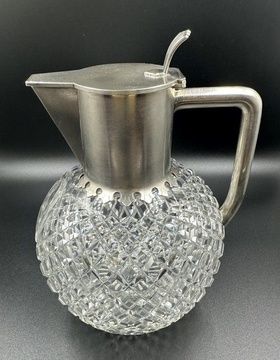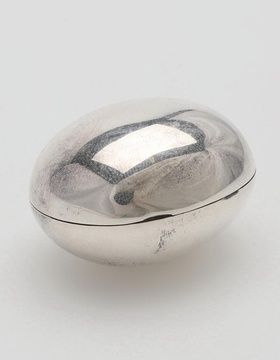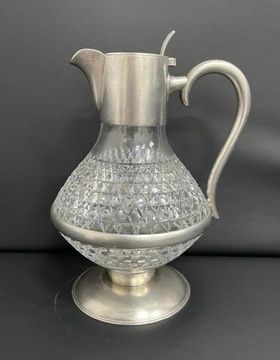Фирма «Болин К.Э.»
Фирма «Болин К.Э.»

Имя фирмы «Болин К.Э.» в массовом сознании находится в тени его многолетнего «молодого» конкурента К. Фаберже.
Хотя специалистам имя Болина так же хорошо известно и значимо, как и имя Фаберже. Причин тому несколько. Дело в том, что Фаберже в свое время сделал несколько гениальных менеджерских ходов, которые и обессмертили его имя, оттеснив на периферию общественного сознания такой бренд, как фирма «Болин К.Э.». Но об этом ниже…
История фирмы «Болин К.Э.»[54] началась в самом конце XVIII в. Начало было весьма основательным, поскольку основатель дела – выходец из Саксонии Андрей Григорьевич Ремплер, приехавший в Петербург в последние годы жизни Екатерины II (1790 г.), уже в период царствования императоров Павла I и Александра I имел престижное звание придворного ювелира и оценщика Кабинета Его Императорского Величества (с 1823 г.)[55]. Как и многие иностранцы, он прижился в России и в 1809 г. принял со всей семьей российское подданство. Это было тревожное время наполеоновских войн, и А.Г. Ремплер поторопился продемонстрировать лояльность новой родине.
Как это часто практиковалось со времен Средневековья, ювелирный «бизнес» был семейным, и после смерти А. Ремплера в 1829 г. дело перешло в руки вдовы и зятя – ювелира Готлиба Эрнста Яна, женатого на старшей дочери Ремплера Софии, еще при жизни тестя он стал его компаньоном. На момент перехода дела в руки Г.Э. Яна тот уже служил оценщиком и являлся поставщиком ювелирных украшений к Императорскому двору.
Готлиб Эрнст Ян вошел в историю ювелирного дела главным образом тем, что в 1831 г. по заказу Николая I выполнил бриллиантовое с опалами ожерелье, обошедшееся императору в 169 601 руб. Ожерелье предназначалось в дар императрице Александре Федоровне от императора по случаю рождения сына – великого князя Николая Николаевича (старшего). Указанная стоимость ювелирного изделия оставалась рекордной до 1894 г.
Часто исследователи указывают на ювелирное изделие, ставшее новым рекордсменом по цене: жемчужное ожерелье, приобретенное в 1894 г. у К. Фаберже за 177 600 руб.[56] Александром III для цесаревича Николая Александровича, которое он подарил своей невесте Алисе Гессенской[57]. Забегая вперед, заметим, что это не так. На самом деле тогда самой дорогой вещью стала сапфировая парюра стоимостью в 212 244 руб., изготовленная Фридрихом Кехли. Второе же место по стоимости тогда заняла рубиновая парюра (190 295 руб.), изготовленная сыном Карла Болина – Эдуардом.
Второй зять А.Г. Ремплера, ювелир Карл Эдуард Болин (1805–1864), прибывший в Петербург в 1831 г., начал свою карьеру бухгалтером у Яна в 1833 г. В 1834 г. он, пойдя проторенным путем, женился на Эрнестине Катарине Ремплер, в результате чего превратился в совладельца фирмы, которая стала называться «Ян и Болин».
После смерти в 1836 г. Г.Э. Яна дела фирмы продолжали успешно вести три родственника: Карл Эдуард Болин, его теща Анна Ремплер и вдова ювелира Яна София (старшая дочь А.Г. Ремплера).
Об успешности дел семейной ювелирной фирмы свидетельствует указ Николая I, состоявшийся в 1839 г. о даровании Карлу Эдуарду Болину и Софии Ремплер звания «придворных ювелиров». Алгоритм получения столь престижного звания был прост и беспроигрышен. Дело в том, что ювелиры обратились с просьбой о присвоении звания непосредственно к императрице Александре Федоровне, которой хорошо была известна продукция фирмы «Ян и Болин». В служебной записке, составленной по повелению императрицы ее секретарем (25 апреля 1839 г.) на имя министра Императорского двора князя П.М. Волконского, указывалось: «Покойный оценщик Императорского Кабинета Андрей Ремплер, которому принадлежал лучший в здешней столице магазин бриллиантовых вещей… Преемники покойного Ремплера, его дочь София Ян и зять Эдуард Болин, настоящие хозяева того же магазина, были равномерно удостаиваемы изготовлять бриллиантовые вещи для Их Императорских Величеств и Их Императорских Высочеств… просить… присовокупить к фирме их магазина звание Придворных ювелиров»[58].
Обратим внимание, что первоначально речь шла только о дочери ювелира Ремплера – Софии Ян и его зяте Карле Эдуарде Болине. В служебных документах, сопровождавших переписку, подчеркивалось, что «работы ювелиров Ремплер Ян всегда производились к удовольствию Ея Императорского Величества и весьма приятно было бы Ея Величеству, если бы можно было удовлетворить их просьбу».
Естественно, просьбу императрицы поддержало и руководство Кабинета. Но в записке, датированной 28 апреля 1839 г., к именам Софии Ян и Карла Эдуарда Болина присоединили еще двух ювелиров: «Отец и муж просительницы, равно как она сама и зять ея Болин действительно делали для Ея Величества и для Кабинета более двадцати лет разные бриллиантовые вещи… обратить внимание Вашей Светлости на оценщиков Кабинета ювелиров Яннаша и Камерера, которые состоя в Кабинете на службе, на штатных местах, первый с 1802 г., а последний с 1835 г., так же делали и делают заказываемые Кабинетом бриллиантовые вещи… с не меньшим искусством и тщанием и, следовательно, имеют более права на звание Придворных ювелиров»[59].
Князь П.М. Волконский возражать не стал и вышел с соответствующими документами на доклад к Николаю I, который 29 апреля 1839 г. и даровал четырем мастерам звания «придворных ювелиров».
О профессиональном уровне Карла Эдуарда Болина косвенно свидетельствуют пометы в «Книге коронных брильянтов, брильянтовых вещей и жемчугов». Когда Николай I в конце 1841 г. начал готовиться к серебряной свадьбе (1 июля 1842 г.), он задумал подарить жене, любившей ювелирные безделушки, дорогое украшение – бриллиантовую диадему с жемчугами. Материал для работы, как уже не раз бывало, предполагалось взять из Бриллиантовой комнаты Зимнего дворца. Эту ответственную работу император поручил именно Карлу Эдуарду Болину, тот давно специализировался на изготовлении дорогих украшений из бриллиантов.
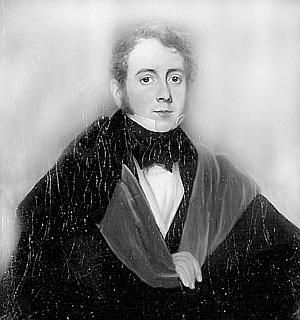
Карл Эдуард Болин. Автопортрет. 1830-е гг.
В «Книге коронных брильянтов, брильянтовых вещей и жемчугов» указано, что из склаважа «5 декабря 1841 г. вынуто 3 бриллианта весом 4 карата на диадему с жемчугами и отпущено ювелиру Болину. Осталось в склаваже 12 бриллиантов». Кроме этого, ради императорского подарка, сломали «изделие» № 289 «Бант бриллиантовый в середине коего большая плоская жемчужина с подвешенными тремя большими же жемчужными неокатистыми панделоками и двумя маленькими, и одним бриллиантовым панделоком, весом около 22 гран».
Еще раз повторим, что бриллианты и жемчуга Карлу Болину выдали 5 декабря 1841 г., а уже 2 января 1842 г. в список вещей Бриллиантовой комнаты внесли за № 629 «Диадему, составленную из коронных брильянтов и жемчугов»[60]. Легендарная бриллиантовая диадема, изготовленная в 1842 г., включала в себя[61] (табл. 6):
Таблица 6

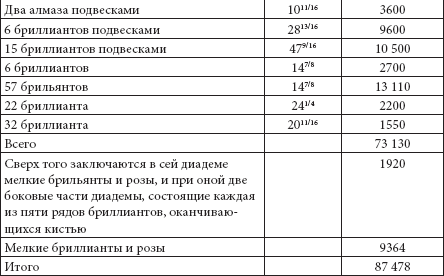
Подобные ответственные поручения бывали и позже. Так, 5 декабря 1852 г. «в присутствии члена Кабинета действительного тайного советника Петухова и камер-фрау Эллис вынуто придворным ювелиром Болиным из букли, значащейся под № 84 из седьмой бриллиантов… употреблены на 2 части колье в виде подвесок»[62]. К этому времени (с 1851 и по 1864 г.) Карл Эдуард Болин состоял оценщиком Кабинета Е.И.В. и был награжден золотыми медалями на Аннинской и Владимирской лентах.
Со временем фирма «Болин и Ян» стала известной не только в России, но и в Европе. Произошло это после успеха на Всемирной выставке 1851 г. в Лондоне, когда английская пресса, освещавшая работу выставки, высоко оценила украшения, изготовленные фирмой Карла Эдуарда Болина. При этом Николай I купил тогда для своей супруги большое украшение с огромными сапфирами и бриллиантами.
Тогда многие считали «невозможным для нашего Отечества первенствовать или даже соперничать с другими государствами, особенно Францией, законодательницей моды и вкуса».
Тем не менее, произведения фирмы «Болин и Ян» удостоились самой высокой похвалы, так как «решительно превосходили совершенством оправы все», что было представлено в Лондоне. Центральное место на витрине фирмы Болина занимало украшение с уникальным рубином в 44 карата и стальной жемчужиной в 19 карат, усыпанное огромным количеством бриллиантов и алмазных роз. Подчеркнем, что в последнее десятилетие правления Николая I и на протяжении всего царствования Александра II фирма «Болин К.Э.» являлась ведущим поставщиком бриллиантовых изделий к Императорскому двору.

Стакан с листьями лавра. Серебро, штамповка, золочение, эмаль. Фирма «К.Э. Болин». Мастерская К. Линке. Москва. 1900-е гг.
В 1864 г. в возрасте 59 лет Карл Эдуард Болин умер. Управление семейной фирмой перешло к его сыновьям – Эдуарду и Густаву, которые с этого же времени стали оценщиками Кабинета и придворными ювелирами. В документах указывается: «Болины, братья Эдуард и Густав, потомственные почетные граждане, ювелиры. О предоставлении им права именоваться придворными Е.И.В. ювелирами высочайшее соизволение последовало в 1864 г.». Ведущую роль в семейной фирме играл Эдуард Болин (1842–1926), именно он создал в 1871 г. Торговый дом «Болин К.Э.»[63], остававшийся вплоть до 1917 г. в числе поставщиков Высочайшего двора.
Эдуард Болин продолжил дело отца. Когда в ноябре 1865 г. проводили ревизию «коронных бриллиантов» в Бриллиантовой комнате Зимнего дворца, то он проверял оценку драгоценностей, проводившуюся ранее его отцом. В документе прямо указывается: «Означенная оценка составлена бывшим при оценке вещей умершим родителем моим оценщиком Кабинета Е.В. придворным ювелиром Болиным и мною проверена. Эдуард Болин»[64].
На Всероссийской мануфактурной выставке в Санкт-Петербурге в 1870 г. изделия фирмы «Болин К.Э.» признали лучшими. В этом «мирном состязании на почве художественной промышленности» участвовали 11 ювелиров из Санкт-Петербурга, Москвы и Гельсингфорса. В результате «первое место, как по изяществу рисунка, совершенству работы, так и по высокой ценности изделий, принадлежало богатой витрине петербургского ювелира господина Болина». Отчасти это была дань уважения профессионального сообщества к умершему коллеге и признание таланта его преемника. Фирма «Болин К.Э.» получила по итогам Всероссийской мануфактурной выставки высшую награду, а именно «право употребления Государственного герба». Напомним, что это был «Герб» от Министерства финансов. Как отмечено в официальном отчете, этой награды мастера удостоили «за совершенную чистоту ювелирной работы, искусный подбор камней и изящество рисунков, при долговременном существовании фирмы». Напомним, что с 1839 г. семейная ювелирная фирма уже имела право использовать в рекламных целях «Герб», полученный от Министерства Императорского двора, по званию «придворного ювелира».
На Всероссийской художественно-промышленной выставке 1882 г. в Москве «продукцию» фирмы[65] «Болин К.Э.» вновь высоко оценили. К этому времени вполне определилось основное направление работы фирмы – крупные ювелирные украшения значительной стоимости. При этом доминирующую роль в этих украшениях, как и «положено», играли дорогие драгоценные камни. Особенностью работы фирмы стал искусный подбор драгоценных камней и необычайно тонкая работа по укреплению этих камней в очень маленьких гнездах. При этом каркас основы изделия фактически становился невидимым, и доминирующую роль в украшении играли именно драгоценные камни. Обозреватели выставки отмечали: «По-видимому, камню не на чем почти держаться; он между тем укреплен плотно и составляет с гнездом как бы одно нераздельное целое. Солидность работы, не вредящая изяществу, блеск, не вредящий вкусу, отмечают произведения г. Болина в ряду других произведений того же рода»[66].
К сожалению, в отличие от Фаберже с его поточным производством драгоценных вещей, дорогие и «штучные» вещи Болина практически не сохранились. Блестящим примером творчества талантливого ювелира является сохранившаяся бриллиантовая диадема с жемчужными подвесками.
Известный исследователь ювелирного дела России Татьяна Николаевна Мунтян предполагает, что эта «выставочная» диадема являлась собственностью великой княгини Марии Павловны, супруги великого князя Владимира Александровича (младший брат Александра III). Мы же в этом уверены. Наша уверенность зиждется на дошедшей до нас фотографии великой княгини, увенчанной этой парадной диадемой, «состоящей из бриллиантовых кругов с подвижно укрепленными в них громадными жемчужинами величиной с небольшую грушу-дичок». Эту диадему в 1918 г. сумели вывезти из революционной России при посредстве английских дипломатов. В Англии великая княгиня Мария Павловна продала диадему английской королеве Мэй (супруге Георга V), и ныне эта диадема является собственностью английской королевы Елизаветы II.
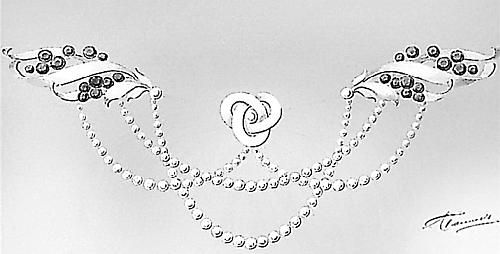
Эскиз ювелирного украшения. Фирма «К.Э. Болин»

Эскиз диадемы, колье, двух вариантов серег из бриллиантов, рубинов, жемчуга и эмали. 1870-е гг.
Отметим – на выставке 1882 г. у фирмы «Болин К.Э.» появился сильный конкурент. Карл Фаберже, впервые представлявший свои работы на выставке, был назван ювелиром сравнительно молодым, но вполне зрелым, первоклассным мастером. Высокую оценку заслужили также фирмы И. Хлебникова и П. Овчинникова, главным образом за то, что у них «находятся почти все образцы, все применения, все виды, обнимающие золотых дел мастерство».
Российские императоры регулярно приобретали у фирмы «Болин К.Э.» традиционные и очень дорогие бриллиантовые украшения.
Фирма «К.Э. Болин». Проект приданого великой княгини Марии Александровны. Начало 1870-х гг.которые буквально служили «обрамлением» для блистающих российских императриц. Поэтому мастеров фирмы «Болин К.Э.» привлекли в 1894 г. для изготовления «приданого Ея Императорского Величества» императрицы Александры Федоровны.


Великая княгиня Мария Павловна в бриллиантовой диадеме с жемчужными подвесками
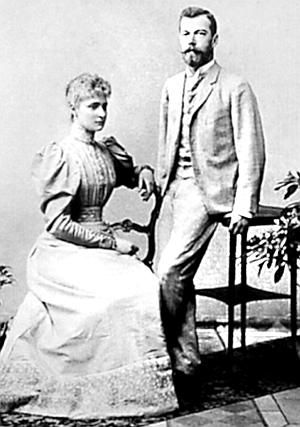

Цесаревич Николай Александрович с невестой Алисой Гессенской. Апрель 1894 г. Кобург
Напомним, что в апреле 1894 г. в Кобурге состоялась помолвка наследника-цесаревича Николая Александровича и принцессы Алисы Виктории Елены Луизы Беатрисы Гессен-Дармштадской.
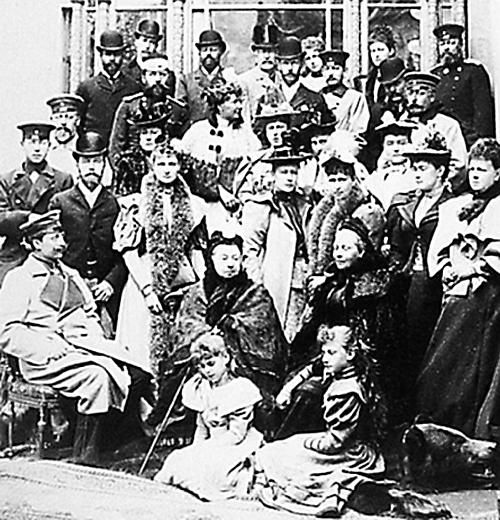
Вильгельм II, королева Виктория, цесаревич Николай, Алиса Гессенская и другие родственники. Апрель 1894 г. Кобург
10 октября 1894 г. она срочно прибыла в императорскую резиденцию Ливадия, где умирал Александр III. По меркам большого света немецкая принцесса приехала в Россию буквально «голая». Накануне поездки ее родственники занимали наличные деньги для того, чтобы сшить невесте приличные платья. 20 октября 1894 г. умер Александр III и невеста цесаревича в одночасье превратилась в невесту российского императора. 7 ноября 1894 г. тело усопшего императора опустили в склеп в Петропавловском соборе Санкт-Петербурга. 14 ноября 1894 г. уже принявшая православие Александра Федоровна вышла замуж за Николая II. Надо признать, что операция «женитьба» была проведена Александрой Федоровной молниеносно, с железной последовательностью и никакой траур по почившему в Бозе Александру III ей в этом не помешал.
Хозяйственные подразделения Императорского двора немедленно начали формирование «положенного» «приданого Ея Императорского Величества», от панталон до драгоценностей. В апреле 1895 г. Канцелярия «Ея Императорского Величества Государыни Императрицы Александры Федоровны» запросила «список драгоценных и меховых вещей, приобретенных Кабинетом в приданое Ея Императорскому Величеству».
В мае 1895 г. поступил список «драгоценных вещей, заготовленных Камеральным отделением Кабинета в приданое Ея Императорского Величества Государыне Императрице Александре Федоровне». В числе прочего в списке значилась рубиновая парюра, изготовленная мастерами фирмы «Болин К.Э.». Парюра обошлась Кабинету в безумные деньги и состояла из ожерелья (88 375 руб.), броши (45 200 руб.), пары серег (20 720 руб.) и диадемы (36 000 руб.). Как легко сосчитать, вся парюра обошлась Кабинету в 190 295 руб.[67]
Попутно упомянем и о том, что самой дорогой вещью в коллекции ювелирного приданого молодой императрицы была сапфировая парюра работы ювелира Фридриха Кехли, оцененная в 212 244 руб. Это была волшебная вещь, в которой центральное место занимали крупные сапфиры Сиама или Бирмы. Колье украшали 58 камней весом в 260 карат, а диадему увенчивали 16 густо-синих сапфиров в окружении бриллиантовых лучей. Удивительно хороша была брошь-севинье из парюры, где сапфировые подвески струились холодным синим водопадом.
Третью позицию по деньгам в ювелирном приданом занимало жемчужное ожерелье «в 5 ниток из 237 зерен, весом 929 карат, с фермуаром из бриллиантов» работы К. Фаберже стоимостью в 171 600 руб. Таким образом, этот престижный заказ наглядно показывает, что фирма «Болин К.Э.» при всех привходящих обстоятельствах прочно входила в первую тройку придворных ювелиров.
Таким образом, весной 1895 г. три ведущих ювелира Санкт-Петербурга (Фридрих Кехли, Эдуард Болин и Карл Фаберже) фактически работали над одним заказом, комплектуя ювелирное приданое императрицы.
Периодически подобные ситуации повторялись. Так, для императрицы Александры Федоровны мастер фирмы «Болин К.Э.» Роберт Швен изготовил колье из десяти бриллиантовых бантов и кулонов с крупными колумбийскими изумрудами-панделоками и тяжелую диадему с четырехугольным пирамидальным кабошоном в 23 карата. Считается, что из-за спешки выполнение пластрона из убора поручили фирме К. Фаберже. Этот гарнитур запечатлен в книге «Алмазный фонд СССР», изданной в 1924–1926 г.[68]
Подобные дорогие заказы фирма «Болин К.Э.» получала и позже. Например, к свадьбе великой княжны Ольги Александровны (младшей сестры императора Николая II) Эдуард Болин сделал несколько парюр из изумрудов, рубинов и бриллиантов, в то время как Карлу Фаберже было поручено изготовление столового серебряного сервиза для невесты. По свидетельству Ф. Бирбаума, главного мастера фирмы К. Фаберже, это был стандартный расклад: «Ювелирная часть приданого поручалась ювелиру Болину, столовое серебро нам»[69].

Ювелирное приданое императрицы Александры Федоровны. 1894 г.
Кроме престижных разовых заказов мастера фирмы «Болин К.Э.» «работали» бесконечную и очень важную «кабинетную бриллиантовую текучку». Так, для поставок Кабинету Е.И.В. фирме преимущественно заказывались: бриллиантовые табакерки с миниатюрными портретами императорской четы; бриллиантовые шифры для статс-дам и фрейлин; бриллиантовые ордена (Св. Андрея Первозванного, Св. Екатерины, Св. Александра Невского, Белого Орла, Св. Анны I и II степени, Св. Станислава I и II степени); табакерки с инициалами монархов и драгоценные кресты с панагиями.
Подчеркнем, что за стабильные заказы Кабинета шла ожесточенная конкурентная борьба, в которой «старую» фирму «Болин К.Э.» активно «подпирали» молодые конкуренты и, прежде всего, фирма К. Фаберже. Так, по данным финской исследовательницы Уллы Тилландер, подарочные табакерки с миниатюрным портретом Николая II за период с 1894 по 1917 гг. изготовили[70] (табл. 7):
Таблица 7

* Ган Карл Август(1836–1899?) австрийский подданный, с 1892 г. российский подданный, с 1874 г. купец, в 1896 г., будучи придворным поставщиком, назначен оценщиком при Кабинете Е.И.В., в 1898 г. получил звание потомственного почетного гражданина. По сведениям 1893 г., мастерская ювелирных изделий К. Гана основана в 1873 г., занималась изготовлением золотых изделий с эмалью, производство ручное, 30 рабочих, годовой оборот 100 тыс. рублей. В 1897 г. К. Ган был награжден орденом Св. Станислава III степени. В 1875 г. К. Ган проживал в доме Шведской церкви по М. Конюшенной улице, а торговал на Невском проспекте, 26 (в 1911 г. помещение магазина перешло фирме А. Тилландер). После смерти К. Гана владельцем фирмы стал сын Дмитрий Карлович, который в 1903 г. получил удостоверение придворного поставщика. В 1900 г. при проверке Пробирной инспекцией магазина были обнаружены неклейменые изделия, а также отмечалось, что «магазин торгует золотыми и серебряными изделиями лучших петербургских мастеров, равно и заграничных фабрикантов». С 1892 по 1909 г. в фирме работал ювелир К.К. Бланк, с 1909 по 1911 г. состоял компаньоном, но после смерти Дм. Гана (1911) фирма прекратила свое существование. Фирма выполнила много вещей для Кабинета Е.И.В., специализируясь на орденах с бриллиантами и других изделиях с камнями. Есть сведения, что фирма сотрудничала с фирмой Картье.
Совершенно очевидно, что одна «портретная» табакерка, заказанная фирме «Болин К.Э.» за все 23 года царствования Николая II, «погоды» совершенно не делала. Значительно больше Кабинет Е.И.В. заказывал табакерок с инициалами императора. Это был стандартный «мужской подарок» к юбилеям сановников, на Рождество и Пасху. За период с 1894 по 1917 гг. известные мастера изготовили таких табакерок[71] (табл. 8):
Таблица 8
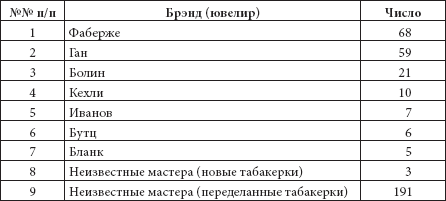
Но и здесь фирма «Болин К.Э.» занимает почетную третью позицию с двадцатью одной табакеркой, при этом лидирующая фирма К. Фаберже изготовила таких табакерок в три раза больше.
Совершенно очевидно, что определяющую роль в судьбе петербургских ювелирных фирм всегда играло внимание представителей императорской семьи к изделиям фирмы. И, в первую очередь, монаршей четы. Такое внимание фирме «Болин К.Э.», безусловно, оказывалось. Об этом достоверно свидетельствуют счета последних лет правления Александра III и Николая II, с личными пометами императоров: «Уплатить». На оплату подобных личных заказов в смете Кабинета (§ 10 ст. 1.) при Александре III ежегодно выделялось 100 000 руб. «на особые Его Величества расходы».
Необходимо уточнить термин «покупка». В буквальном, привычном для нас смысле императорская чета покупала ювелирные изделия только заграницей. Да и то очень редко. Пожалуй, последним российским императором, лично посещавшим в Петербурге «Английский магазин Никольс и Плинке», был Николай I, который сам выбирал в витринах магазина ту или иную вещь. Оплачивало выбранную вещь Министерство Императорского двора. Поскольку при Александре II зародилось такое явление, как политический терроризм, императоры по магазинам ходить перестали. Со времен Александра II драгоценности доставлялись в императорские резиденции, где первые лица выбирали из них требуемое. Поэтому термин «купить» в приложении к императорам очень условен. Деньги они, конечно, платили, но исчезла прелесть шопинга.

Коробочка. И.А. Флинк. Фирма «Болин К.Э.»
Если предметно рассмотреть по годам счета покупок (1890, 1891, 1892, 1895, 1896, 1897, 1898, 1899, 1902 гг.), включая номенклатуру изделий, то картина вырисовывается следующая.
В феврале 1890 г. Александру III представили для выбора различные ювелирные вещи, из числа которых он должен был выбрать подарок для великой княгини Елизаветы Маврикиевны. В документе не указываются имена конкурентов, но из всех представленных вещей выбрали «брошь с бирюзою и бриллиантами под № 36715 в 3760 руб.» работы «ювелира Болина». Об участии в «просмотре» драгоценностей императрицы Марии Федоровны свидетельствует помета в документе, сообщающая, что выбранная брошь «осталась у Ея Величества»[72].
В том же феврале 1890 г. в магазине Болина только по одному счету приобрели различных брошек (жемчуг и бриллианты, сапфир и бриллианты, рубин и бриллианты, бирюза и бриллианты и т. д.), браслетов (сапфир и бриллианты, рубин и бриллианты, кораллы и т. д.), колье (с бирюзой, с аметистами) и сережек (с кораллами, с бирюзою) на 36 995 руб.[73]
 Счет фирмы «К.Э. Болин» 5 февраля 1890 г. (РГИА. Ф. 468. Оп. 13. Д. 781. Л. 9)
Счет фирмы «К.Э. Болин» 5 февраля 1890 г. (РГИА. Ф. 468. Оп. 13. Д. 781. Л. 9)
О. Браз. Портрет великой княгини Елизаветы Маврикиевны
Выбранные вещи были представлены в довольно широком ценовом диапазоне, но с преобладанием очень дорогих изделий. Самыми дорогими в этом счете оказались две броши, стоимостью в 5900 руб. (жемчуг и бриллианты; рубин и бриллианты) и браслет (сапфир и бриллианты) в ту же цену. Самой дешевой вещью – пара сережек с бирюзою за 140 руб.
В мае 1890 г. последовали новые крупные покупки – две броши на 18 350 руб. (с рубином кабошоном и бриллиантами; с сапфиром и бриллиантами), купленные в подарок великой княгине Александре Георгиевне. Затем, возможно, на день рождения старшего сына-наследника (счет от 30 апреля, день рождения 6 мая) родители купили пару запонок с сапфирами за 225 руб.
Любопытно, что «по традиции прошлых лет» счета фирмы «Болин К.Э.» выписывались преимущественно на французском языке. По принятым стандартам в счетах указывался номер ювелирного изделия, под которым оно вносилось в товарные книги фирмы, вместе с именем покупателя: «Brochediamands № 37528 – 435 руб.»; «Braslet Rubis № 37219 – 480 руб.»[74]. Кстати говоря, в годы Гражданской войны в России (1917–1922 гг.) товарные книги были изъяты славными органами ВЧК. По этим книгам хорошо было видно, что, кто и сколько покупал у Болина. Именно такой «материал» требовался для организации обысков с целью изъятия драгоценностей.
Очень дорого у ювелиров стоил жемчуг. В мае 1891 г. по счету фирме «Болин К.Э.» уплатили с именного царского счета за браслет «из 80 жемчужин и бриллиантовых частей» 7325 руб.
Для семьи Александра III был особым 1891 г. В октябре царственная чета скромно отметила свою серебряную свадьбу, получив множество подарков. Главным подарком от всей императорской фамилии стали серебряные каминные часы работы мастеров фирмы К. Фаберже.
В свою очередь и царственные юбиляры посчитали своим долгом «отдариться». Об этом свидетельствует ноябрьский счет фирмы «Болин К.Э.» на 18 525 руб. Номенклатура счета довольно широкая, но все предметы были традиционными украшениями: брошь изумрудная с жемчугом (1400 руб.); пара запонок рубиновых (285 руб.); веер (540 руб.); булавка сапфировая (275 руб.) и т. д.
Часть предметов, проходивших по этому счету, мастера фирмы Эдуарда Болина изготовили с указанием юбилейных дат: пара запонок «XXV» рубиновых (400 руб.); брошь «XXV» рубиновая (450 руб.); пара запонок «XXV» сапфировых (380 руб.); брошь «XXV» жемчужная (325 руб.). Относительно невысокая цена украшений говорит о том, что эти вещи предназначались для подарков слугам, входившим в «ближний круг» императорской семьи. При этом дата «XXV» свидетельствовала, что это были люди, служившие императорской чете, начиная с 1866 г. и, возможно, приехавшие вместе с принцессой Дагмар из Дании.
На начало 1890-х гг. фирма «Болин К.Э.» оставалась ведущей среди поставщиков Императорского двора, как по количеству закупаемых у нее вещей, так и по общей сумме закупок. Об этом наглядно свидетельствуют счета «юбилейного» 1891 г.[75] (табл. 9):
Таблица 9
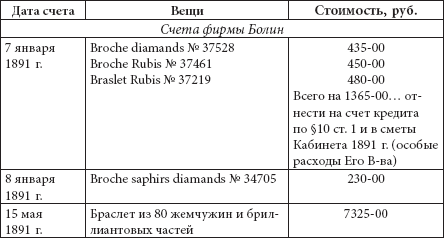

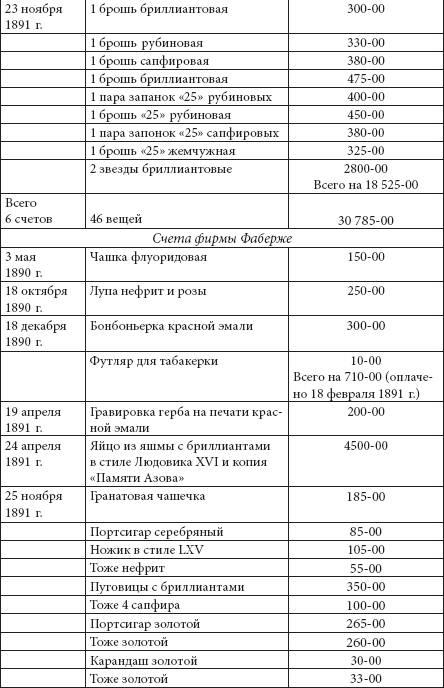

Таким образом, фирма Эдуарда Болина продала за 1891 г. по личному выбору Александра III ювелирных изделий на 30785 руб., против довольно скромных 7008 руб. Фаберже.
Конечно, год на год не приходился, но фирма «Болин К.Э.» устойчиво сохраняла лидерство и в обычные, неюбилейные, года. Например, в 1892 г. соотношение «по вещам», «счетам» и «суммам» было следующим[76] (табл. 10):
Таблица 10
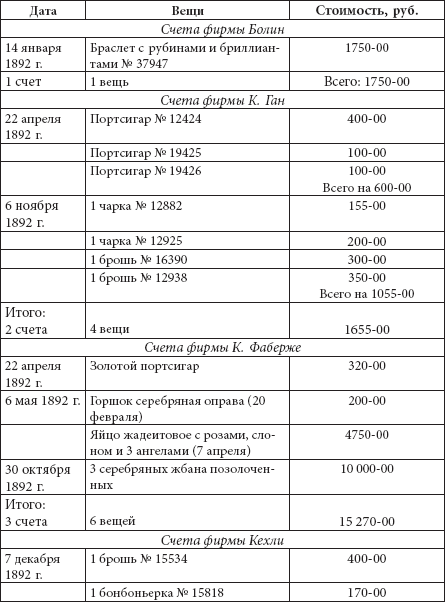

Как мы видим, в 1892 г. Болин уступает лидерство своим конкурентам – Карлу Фаберже и Фридриху Кехли.
С 1895 г. Николай II начинает покупать вещи у «Болина К.Э.» уже как император. Характерно, что именно тогда царственные супруги впервые начинают «сбрасываться» на подарки, оплачивая по 50 % подарочной вещи. Впервые «у Болина» такой счет на 4440 руб. прошел 28 мая 1895 г. Тогда супруги купили пополам (по 2200 руб.) кому-то в подарок колье и два браслета с рубинами и бриллиантами. Отметим, что Александр III и Мария Федоровна подобную методу не практиковали.
На Рождество 1895 г. Николай II совершил у «Болина К.Э.» дорогую покупку: «3 пуговицы жемчужные с бриллиантами» за 7000 руб. Счет оплатили в январе 1896 г.[77] Скорее всего, эти пуговицы, как воспоминание о XVIII в., император купил для супруги, обожавшей жемчуг. Это был личный подарок мужа жене под рождественскую елку.
Еще одним семейным праздником для Николая II стал день помолвки 8 апреля. Кроме этого, на 23 апреля приходился день тезоименитства молодой императрицы. Подарки от мужа в эти дни, как правило, носили ювелирный характер. Так, по счету фирмы «Болин К.Э.» от 17 апреля 1896 г. Николай II оплатил: 6 пуговок жемчужных (14 000 руб.); брошь бирюзовую с бриллиантами (2100 руб.); брошь изумрудную (2760 руб.) и пару изумрудных серег (6800 руб.). Всего по счету император уплатил 25 670 руб. Еще раз отметим – лимит средств, ежегодно отпускавшихся царю из средств Кабинета, определялся в 100 000 руб. Так что подарок «дорогой» (в буквальном смысле) жене съел четверть годового ювелирного бюджета. При этом на Рождество 1895 г. и на день рождения 1896 г. Николай II подарил жене сразу 9 дорогих жемчужных пуговок, чего было вполне достаточно для оформления роскошного платья.
Май 1896 г. навсегда стал памятным Николаю II и его жене, ведь это был год их коронации. А коронация – это множество гостей, которым положено дарить соответствующие подарки с коронационной символикой. Тогда на это событие работали все придворные ювелиры. Работала и фирма «Болин К.Э.». Бо?льшая часть подарков закупалась непосредственно Кабинетом, но часть из подготовленных вещей выбиралась лично императором.
О торжественности события свидетельствовали личные подарки царя, например «брошь корона изумрудная» (875 руб.). Расходов тогда было так много, что они ощутимо ударили даже по личному состоянию Николая II. Поэтому царь экономил в буквальном смысле. Как говорят в России: «У кого щи пустые, а у кого жемчуга мелкие». Так, на счете фирмы «Болин К.Э.» от 2 мая 1896 г. указана сумма 26 365 руб. на уже отобранные царем драгоценности. Отметим, что, как свидетельствуют современники, старший сын Александра III на ценники не смотрел, а брал понравившиеся предметы. Но, видимо, увидев серьезную итоговую сумму и вспомнив, что в апреле уже потратил на жену столько же, а впереди еще множество дней рождений, тезоименитств и Рождество, император серьезно скорректировал сумму счета, лично вычеркнув самые дорогие вещи. Например, вычеркнута «брошь с короной рубиновая» за 1300 руб. В результате сумма этого счета составила 12 180 руб.[78] Отметим, что подобное на бланках «царских счетов» практически не встречается, поскольку сначала император сам отбирал вещи, а уже затем они оформлялись в виде счета. Но в данном случае император передумал буквально в последний момент.
Эти вычеркивания самодержавного императора, старавшегося уложиться в 100 000 руб. в год на ювелирные изделия, видимо, смутили чиновников Кабинета. Молодому императору немедленно объяснили, что 100 000 руб. на драгоценности не константа. И если император превысит эту сумму, то сверхсметные расходы немедленно оплатят из статьи «непредвиденные издержки» (§ 5). После этого Николай II уже спокойнее смотрел на счета ювелиров. И следующий коронационный счет от 12 июля 1896 г. на 25 040 руб. царь подписал уже без всяких вычеркиваний.
У Болина в тот год Николай II купил много ювелирной мелочи, относительно недорогой по деньгам, но ценной, как императорский подарок в память о коронации. При этом бо?льшая часть ювелирной мелочи покупалась пополам с императрицей Александрой Федоровной. Еще раз отметим, что эти счета «пополам» появились только в период царствования Николая II и являлись наглядной демонстрацией личностных особенностей императрицы Александры Федоровны. Пополам они купили броши, булавки, запонки, серьги и пр. Например, по счету от 12 июля 1896 г. куплена брошь «лунный камень и бриллианты» (430 руб.), за которую каждый из супругов заплатил по 215 руб.
Были и другие семейные праздники, и памятные дни, когда Николай II с удовольствием дарил жене ювелирные подарки. В августе 1896 г. Николай II отобрал из вещей фирмы «Болин К.Э.» для подарка жене сапфировый браслет (1590 руб.); пару изумрудных запонок (1250 руб.); три головные булавки (сапфировую, бриллиантовую, сапфировую с рубином: 220, 350 и 350 руб.) и три безумно дорогие жемчужные пуговицы (7000 руб.)[79].
Точное указания числа «взятия» той или иной ювелирной вещи указывает на наличие в Камеральной части некоего обновляющегося фонда драгоценных вещей от различных ювелиров. В случае необходимости эти вещи немедленно доставлялись императору, и он выбирал то, что понравилось. Кабинет направлял ювелиру список выбранных вещей, и после выставления ювелиром счета их оплачивал. Такой порядок фактически исключал императора из личных контактов с ненужными людьми, но при этом, наверное, лишал и радости шопинга. Только в очень редких случаях император лично общался с ювелирами, которые должны были изготовить какую-либо вещь по идее императора. Впрочем, ювелирам об этой идее могли сообщить и чиновники Камерального отделения Кабинета или кто-то из великих князей. Так было с идеей пасхального яйца императорской серии 1885 г., когда связующим звеном между царем и ювелиром выступал великий князь Владимир Александрович.
На Рождество 1896 г. Александра Федоровна получила от мужа очередную жемчужную с бриллиантами пуговицу «от Болина» (1650 руб.). Кроме этого, супруг подарил жене брошь жемчужную с бриллиантами (8500 руб.) и брошь аметистовую с бриллиантами (4650 руб.)[80]. Еще раз отметим, что подарки были и от других ювелиров, но мы пытаемся вычленить историю вещей «от Болина», которых, напомним, до наших дней дошло очень мало.
Принято считать, что на Пасху «яйца» покупались только у Фаберже. Это далеко не так. Судя по документам, часть небольших пасхальных яиц покупалась и у Эдуарда Болина. Например, на Пасху 1897 г. Николай II пополам с женой купили у Болина два недорогих сапфировых яйца (35 и 60 руб.).
Когда в апрельских счетах от Болина видишь жемчужные и очень дорогие вещи, то можно с уверенностью предполагать, что это очередной подарок жене в память об апрельской помолвке и тезоименитстве. Они всегда помнили этот день, изменивший ход их жизни. Николай II, крайне скупой на эмоции, в своих дневниках в этот день неоднократно писал прочувствованные слова. Например, в первую годовщину помолвки (8 апреля 1895 г.) он записал в дневнике: «Годовщина нашей помолвки! Никогда в жизни, кажется, я не забуду этого дня в Кобурге – как я тогда был счастлив во всех отношениях. Чудный незабвенный день!». Спустя 10 лет (8 апреля 1904 г.) он уже скупо и без всяких эмоций констатировал: «Сегодня десятилетие нашей помолвки». Вне зависимости от эмоций ювелирный подарок для жены готовился очень дорогой и, как правило, «от Болина». Даже после отречения, когда за короткое время очень многое изменилось в жизни уже «граждан Романовых», они помнили об этом дне. 8 апреля 1917 г. гражданин Николай Романов записал в дневнике: «Тихо справляли 23-ю годовщину нашей помолвки».
Возвращаясь к апрельским счетам 1898 г., мы видим, что по счету от 9 апреля 1898 г. проходила «брошь жемчужная» за 7640 руб. и по счету за май этого же года – «подвеска жемчужная» за 6800 руб. По последнему же счету проходила и «брошь сердце бриллиантовое» за 7550 руб.[81]
На Рождество 1898 г. Николай II подарил жене традиционно дорогой жемчуг «от Болина» – «пару серег с темными жемчужинами» (17 000 руб.).
Отметим, что одной из традиций Императорского двора являлось твердое следование «традиции прежних лет». Одной из семейных традиций стали подарки ювелирных изделий с жемчугом. Традиционно много жемчуга шло «от Болина». Можно предположить, что если К. Фаберже со своими ведущими дизайнерами ежегодно продумывал очередную композицию пасхального яйца из императорской серии, то также и дизайнеры фирмы «Болин К.Э.» продумывали украшения из жемчугов к очередному апрелю. И апрель для императрицы Александры Федоровны стал месяцем традиционных, очень дорогих ювелирных подарков, когда на Пасху она получала драгоценное пасхальное яйцо «от Фаберже», а на день помолвки и тезоименитство какую-нибудь дорогую вещь из жемчугов «от Болина».

Императрица Александра Федоровна. Открытка. Нач. XX в.
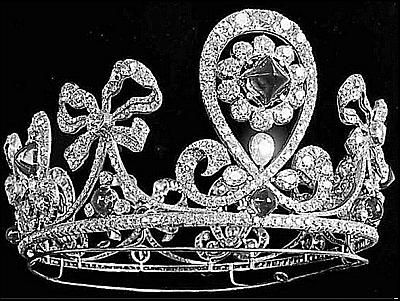
Диадема из бриллиантового гарнитура с изумрудными кабошонами. Фирма «Болин К.Э.
Отметим и то, что украшения «от Болина» с жемчугами – в отличие от известных поименно пасхальных яиц К. Фаберже – практически ушли от нас, канув в Лету. Глядя на парадные и семейные фотографии императрицы, на которых Александра Федоровна обильно «декорирована» жемчугами, мы можем только предполагать, когда она получила то или иное украшение. Судя по счету за 30 апреля 1899 г., Николай II подарил 27-летней жене на день помолвки жемчужное колье с бриллиантами за 46 600 руб.[82]
К сожалению, в архивных делах зияют пробелы, и следующие счета от Болина мы имеем только за 1902 г. В этот год, считая с Рождества 1901 г. и по апрель 1902 г., Николай II потратил на вещи «от Болина» почти рекордные для одного счета 94 712 руб. В счет вошли и недорогие рождественские подарки (видимо, не для жены) – «пряжка серебряная» за 62 руб. 50 коп. и дорогие апрельские подарки жене – «диадема с изумрудами» за 89 800 руб.[83]
Таким образом, за 8 лет Николай II купил только в фирме «Болин К.Э.» 179 драгоценных вещей почти на полмиллиона рублей (474 838 руб.). На эти годы пришлись и коронационный 1896 г., и относительно рядовой 1902 г., но эти годы схожи примерно равными тратами в фирме Болина (90 130 руб. и 109 479 руб.). Отметим, что Э. Болин, несмотря на появление новых ювелирных тенденций, оставался верен политике фирмы, принесшей ей признание и имя. Это изготовление дорогих ювелирных украшений. Добротная ювелирная бижутерия хотя и имела место в продукции фирмы, но основные траты царской семьи приходились на очень дорогие вещи с «серьезными» камнями. К таким покупкам Николая II можно отнести подарки жене на Рождество, дни рождения и тезоименитство, день помолвки и дни рождения детей. Несмотря на некоторую старомодность, которая воспринималась царственными покупателями как здоровый профессиональный консерватизм, фирма Э. Болина вышла к началу XX в. на некий вневременной уровень, позволявший ей уверенно оставаться в обойме царских поставщиков-ювелиров.
Устойчивое положение фирмы, тесные контакты с Кабинетом Е.И.В. и членами императорской семьи приносили свои дивиденды, в частности в виде орденов и званий. Так, купцы 1-й гильдии, братья Эдуард и Густав (1844–1916) Болины одновременно в 1883 г. получили ордена: первый – орден Св. Владимира III степени, дававший право на личное дворянство; второй – орден Св. Анны II степени, дававший право на потомственное почетное гражданство. Спустя годы, тоже почти одновременно, братья получили звания коммерции-советников: Эдуард в 1905 г., Густав в 1906 г.
Братья так и шли по жизни в одной связке – потомственное дворянство даровано обоим в 1912 г. именным сенатским указом Николая II[84]. В представлении на имя министра Императорского двора В.Б. Фредерикса указывалось: «За все многолетнее существование фирма семьи Болин отличными образцами работы своих мастерских постепенно подымала ювелирное дело до высокой техники исполнения и способствовала тем самым искусству и художественному вкусу». И далее подчеркивалось, что на протяжении десятилетий фирма «несла беспорочную службу Кабинету Его Императорского Величества и всегда пользовалась знаками благоволения со стороны своих Высоких заказчиков».
Таблица 11
Личные покупки императора Николая II «от Болина»


Это были вполне справедливые слова, поскольку ювелирам приходилось изыскивать все новые и новые творческие «ходы», для того чтобы соответствовать требуемому высокому уровню изделий при довольно ограниченном ассортименте кабинетных изделий.
Следует подчеркнуть, что в то время большинство ювелиров даже не мечтали получить потомственное дворянство. Новоиспеченным дворянам Болиным составили фамильный герб, на котором главное место занимал «булинь» – снасть парусного судна, она соседствовала с изображением драгоценного камня. Этот булинь, созвучный с фамилией ювелиров, напоминал и о том, что один из отцов-основателей ювелирной фирмы – Карл Эдуард Болин – прибыл в Россию в 1831 г. после того, как его отец-моряк утонул в марте того же года.
Судьба еще одного ювелира семьи Болина – Генрика Конрада (Андрея) Болина (1818–1888), брата Карла Эдуарда, была в большей степени связана с Москвой. Приехав в Россию 1836 г., вслед за старшим братом, Генрик Конрад сначала на протяжении 16 лет работал в семейной фирме в Санкт-Петербурге. Но когда фирма завоевала себе прочное положение в Петербурге, возникла необходимость распространения деятельности фирмы и на Москву. В 1852 г. вместе с англичанином Джеймсом Стюартом Шанксом Андрей Болин основал фирму «Английский магазин. Шанкс и Болин».
Таким образом, предприятие открылось в Москве задолго до филиала фирмы Фаберже, за двадцать лет до открытия фирмы И. Хлебникова и приблизительно в одно время с еще одним «китом» московской ювелирной торговли – предприятием П. Овчинникова.
В Москве «Шанкс и Болин» стали развивать, прежде всего, серебряное производство. После смерти Генрика Конрада Болина в 1888 г. Шанкс основал собственную мастерскую, помимо прочего выпускавшую изящные украшения, не уступавшие по качеству произведениям ведущих московских фирм, и разного рода серебряные изделия, в том числе оправы для великолепного английского фарфора и фаянса знаменитых марок.
Сын Генрика Болина Вильгельм (Василий Андреевич) вынужден был обратиться за помощью к своим петербургским кузенам Эдуарду и Густаву, чтобы продолжить семейный бизнес. В период с 1888 по 1912 гг. московское предприятие по образцу петербургского называлось «Болин К.Э.». После того как Василий Андреевич прочно встал на собственные ноги и расплатился с долгами, московский филиал был переименован и фирма стала носить название «В.А. Болин».
Магазин фирмы помещался на одной из самых фешенебельных улиц древней столицы, на «бриллиантовой» улице Москвы – на Кузнецком мосту в доме № 12, недалеко от магазина фирмы К. Фаберже. Московское отделение ориентировалось на массового покупателя из широких слоев населения, и в его ассортименте значительную часть составляла серебряная утварь: посуда, столовые приборы, разнообразная галантерейная продукция. Именно Вильгельм Болин, возглавлявший московское отделение Торгового дома «Болин К.Э.», последним в этой семье получил звание поставщика Императорского двора в 1912 г.
Расцвет деятельности предприятия приходится на рубеж XIX и XX столетий, и многие из сохранившихся изделий несут на себе приметы стиля «модерн», столь популярного в древней столице в отличие от аристократического Петербурга с его традиционной ориентацией на классику. Недаром современники писали, что «все модернистское шло из Москвы и так или иначе связано с ней».
Художники фирмы, среди которых были выходцы из Франции, обращались к искусству прошлого, предпочитая интерпретировать высокие классические стили Людовика XV, Людовика XVI, ренессанс, ампир, а также использовали характерный пластический язык общеевропейского «ар Нуво». Но в основе этого сложного сплава разнохарактерных приемов и элементов лежало подлинно русское чувство, характерный московский шарм, специфический национальный оттенок с его праздничностью, живописностью и поэзией.
В начале ХХ в. московская фирма «В.А. Болин» была на подъеме. Ее владелец Василий Андреевич отправился в Германию, чтобы открыть в Бад-Хохенбурге – курортном месте, где отдыхала европейская знать, еще один магазин. Там его застала Первая мировая война. Василий Андреевич решил вернуться в Россию через Швецию, где банкир К.А. Валленберг уговорил его открыть магазин в Стокгольме. Это произошло в 1916 г. в торжественной обстановке и в присутствии шведского короля Густава V. С тех пор и до сегодняшнего дня владельцы фирмы «Болин» являются поставщиками драгоценностей Шведского королевского двора.
Аукцион искусства и старины art-picture.ru предоставляет возможность покупки
приобрести представленны лоты по теме "Фирма «Болин К.Э.»"


